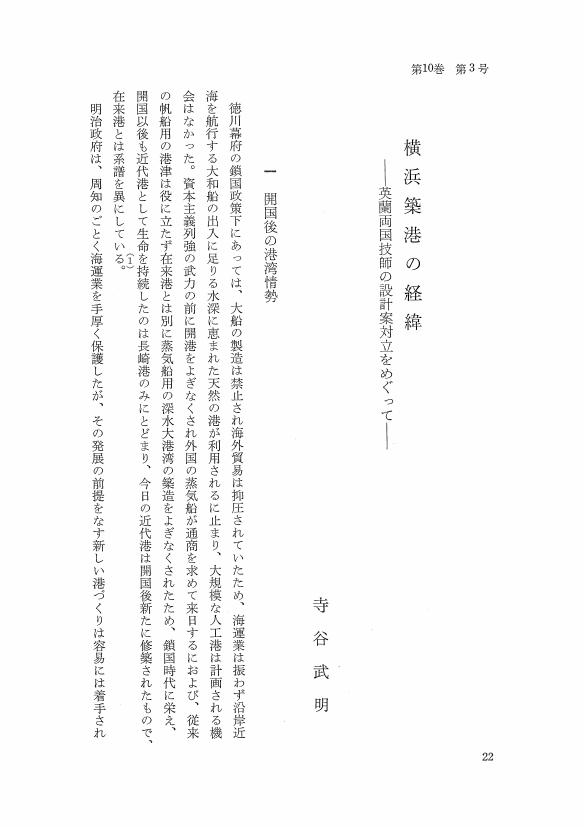1 0 0 0 OA 横浜築港の経緯 英蘭両国技師の設計案対立をめぐって
- 著者
- 寺谷 武明
- 出版者
- 経営史学会
- 雑誌
- 経営史学 (ISSN:03869113)
- 巻号頁・発行日
- vol.10, no.3, pp.22-41, 1975-03-20 (Released:2009-11-06)
1 0 0 0 OA 第一次大戦下における日本造船業の経営転換策 横浜船渠を中心として
- 著者
- 寺谷 武明
- 出版者
- 経営史学会
- 雑誌
- 経営史学 (ISSN:03869113)
- 巻号頁・発行日
- vol.6, no.2, pp.1-24, 1971-11-10 (Released:2009-10-14)
The activities of the Japanese shipbuilding firms in the formative years of the industry were much diversified like “general shops” in engineering just to overcome the difficulties in their main lines. But during world war I the industry was favoured with a great deal of orders from abroad and at home, and most of the firms could be specialized into shipbuilding perse, cutting off the other engineering departments.This paper investigated the case of Yokohama Dock Company, one of the oldest dock yards in Japan. This firm was noted for their early adoption of the form of joint stock company, but they quited the form in spite of its merit, and excluding foreign stockholders, they developed themselves into an independent, specialized shipbuilder.
1 0 0 0 OA 第一次世界大戦下に澄ける日本造舶業の鉄鋼材確保策 -浅野造船所の事例-
- 著者
- 寺谷 武明
- 出版者
- 経営史学会
- 雑誌
- 経営史学 (ISSN:03869113)
- 巻号頁・発行日
- vol.4, no.3, pp.25-53,ii, 1970-07-25 (Released:2010-11-18)
The unprecedented boom of the Japanese shipbuilding industry during World War I was accompanied by a serious difficulty in procuring raw materials. The domestic iron and steel industry had not yet developed enough to supply the local demand. In addition, England and America put into effect an embargo on iron and steel in 1916 and 1917 respectively. The Japanese shipbuilding industry, favored with a great deal of orders from abroad, tried to overcome the shortage of raw materials, first by contracting with the U.S. Government for a supply of iron and steel in return for an equivalent amount of ships, constructed at Japanese shipbuilding yards.But eventually some of the shipbuilding firms, such an Mitsubishi, Kawasaki and Asano, implemented a more long-ranged project for securing raw material; that is, ventures into iron and steel production themselves. In this paper the author has elucidated the procurement policy of Asano Shipyard, established by Soichiro Asano, president of the Toyo Steam-ship Navigation Co.
1 0 0 0 OA 日本造船業成立期における政府と企業 -造船奨励法と石川島造船所-
- 著者
- 寺谷 武明
- 出版者
- 経営史学会
- 雑誌
- 経営史学 (ISSN:03869113)
- 巻号頁・発行日
- vol.2, no.2, pp.85-119,iv, 1967-09-30 (Released:2009-11-11)
Japan's protective policy towards its ship-building industry originated in the enactment of the Ship-Building Promotion Law in 1896. It was intended not to protect particular companies, but to increase the total building capacity of the country by offering premiums for the building of new steel ships larger than 700 tons gross. However, the response to this protective policy and its effects on individual businesses varied markedly depending on the particular circumstances of each ship-yard. This paper attempts to examine the characteristics of the response made by the Ishikawajima Ship-Building Yard to the new law, and the nature of the decisions made by Eiichi Shibusawa, chairman of the company, in the face both of opportunity and crisis.The Ishikawajima company built a large new yard at Uraga in response to the Promotion Law, but it was unable to utilize the yard to its full capacity because of the absence of intimate contacts with major shipping companies, and thus could not take advantage of the premiums offered by the new law. Shibusawa, quick to recognize his mistake, had the foresight to curtail the business, sell the new yard to a competitor, the Uraga Dock Company, established in 1896, and to expand his company's construction of machinery. As a result the company managed to escape total failure, and in a few years had entirely recovered financially. The Uraga Dock Co., meanwhile, was equally unable to take advantage of the huge yard it had bought from Ishikawajima, and its business, too, began to decline gradually.By contrast, both the Mitsubishi and Kawasaki Ship-Building Yard's kept intimate contact with the leading shipping companies, such as Nippon Yusen and Osaka Shosen, and were thus able to secure huge premiums and solidify their positions in the industry.
